by Larry Williams | Sep 2, 2013
Despite the fact that winter annual weeds are not currently growing, we are approaching the best time to prevent them from being seen in our North Florida lawns.
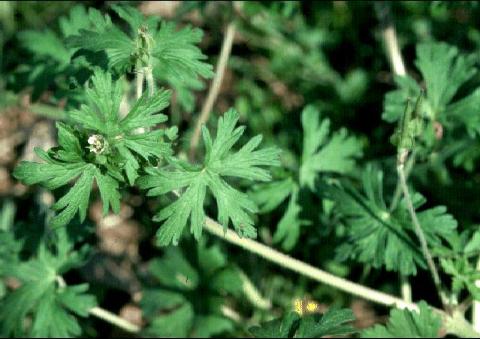
Carolina Geranium
Common winter annual weeds include annual bluegrass (Poa annua), chickweed, henbit, hop clover, lawn burweed and Carolina or wild geranium.
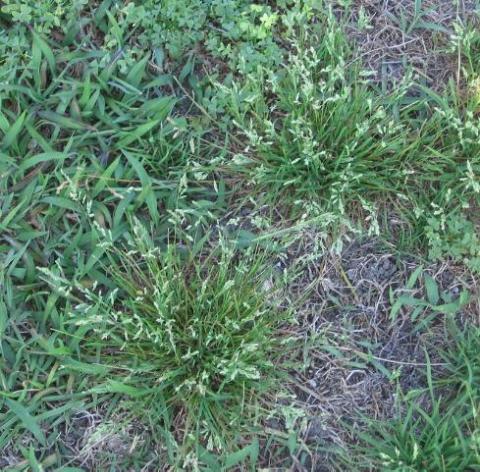
Annual Bluegrass Photo Credits: UF/IFAS
These and other winter annual weeds germinate from seeds in late fall and early winter. The little seedlings go unnoticed but continue to slowly grow through the colder winter months. Approaching spring, as day length becomes longer and soil temperatures warm, these previously inconspicuous weeds put on a growth spurt.
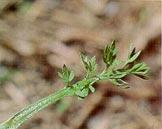
Lawn Burweed:
Close up of parsley-like leaves. Note sharp spines in leaf axils.
Photo Credits: Weeds of Southern Turfgrasses
During spring, the winter weeds may outgrow the lawn grass in our North Florida yards. They begin producing numerous flowers followed by thousands of seeds. For example, one chickweed plant can produce over 15,000 seeds.
In late spring or early summer with the onset of higher temperatures, the parent plants that started their lives from seeds the previous fall will die. But they leave behind a multitude of seed. These seed last the hot summer months dormant in your lawn. Then, in late fall and early winter, they germinate, beginning the entire cycle again.
Late September to early October, when nighttime temperatures drop to 55° to 60°F for several consecutive nights, is the time to apply a pre-emergence herbicide to interrupt the cycle of life for these winter annual weeds. This is just before seedlings emerge.
For season-long control, a second application may be needed about nine weeks after initial application. Not every lawn needs an application of pre-emergence herbicide. If your lawn has had no problem with winter annual weeds, there’s probably no need to apply a pre-emergence herbicide. Use pre-emergence herbicides only on lawns that have been established for at least a year. Many preemergence products interfere with grass seed germination. So, delay reseeding 6 to 16 weeks after application. This also applies to over-seeding a lawn with rye grass seed. Always follow label directions and precautions when using any pesticide, including herbicides.For specific pre-emergence herbicide recommendations, please consult this Weed Management Guide.
by Larry Williams | Aug 12, 2013
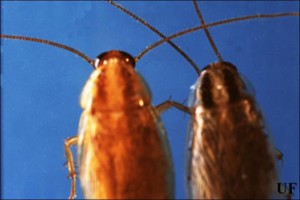
German cockroach (left), Asian cockroach (right). Credit: Dina L. Richman, University of Florida
When people first see Asian cockroaches they may think they are seeing little flying moths. Or they may believe they are seeing German cockroaches because the two species look similar. Keen observation will indicate that there are differences, particularly in behavior.
In appearance, both German and Asian cockroach adults are about 5/8 inch long and are brown in color with two darker parallel bands running lengthwise behind their head. But unlike German cockroaches, Asian cockroaches are strong fliers with sustained flights of at least 120 feet. As a person is watering a mulched plant bed with a hose, the water disturbs the roaches and they quickly fly out of the mulch, resembling little moths. Or home gardeners may see them flying out of the lawn during mowing.
German cockroaches prefer to live indoors and are a major household pest as a result. Asian cockroaches prefer to live outside in mulched beds, compost piles and lawns. Their numbers can be high with populations of 30,000 to 250,000 per acre.
They become active at sundown and are attracted to lights. They often fly inside through any opening in a house such as lighted doorways or windows. Once inside, they fly to and crawl on illuminated television or computer screens and walk on walls while lights are on during the evening. This is when people believe they are seeing a German cockroach invasion in their house, but German cockroaches do not fly.
Many people become upset when they see Asian roaches inside their home. The good news is, however, that indoor infestations are rare occurrences.
Asian cockroaches are susceptible to insecticides but they are difficult to control because of their abundant population and their ability to fly considerable distances.
Because they can fly 120 feet or more in a single flight, large areas around a home require treatment. And cockroaches in surrounding untreated areas may result in re-infestation.
Residual sprays around the perimeter of structures are usually unsuccessful because of numerous infested areas in adjacent lawns, mulch and wooded areas. Adults enter homes through windows and doorways and immediately fly to walls, avoiding baseboards and other typical areas normally treated for German cockroaches.
Best control has been attained by using insecticide baits (labeled for roach control) in infested areas outdoors.
For additional information on Asian cockroaches and their control, contact your local University of Florida / IFAS Extension Office or Pest Control Operator.

by Larry Williams | Jul 22, 2013
Gray Leaf Spot is a common fungal disease of St. Augustinegrass. Recent wet conditions have promoted this disease. This includes high humidity, heavy dews and particularly frequent afternoon and evening rains.
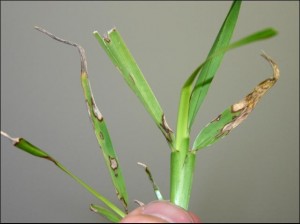
Gray leaf spot symptoms on St. Augustinegrass. Photo credit: UF/IFAS Extension
The individual spots or lesions are first seen as tiny brownish spots smaller than a pinhead. As they become larger, they will be circular and then begin to elongate lengthwise along the leaf. The spots will become brown to grayish in appearance. Numerous spots or lesions may be found on an individual leaf. Heavily infected leaves begin to turn brown and wither, usually beginning at the tip of the blade.
Gray leaf spot can move rapidly during prolonged warm, wet periods. Over watering or irrigating in the evening provides the prolonged period of wetness required for disease infection. For more information on how to correctly water a Florida lawn, visit the UF / IFAS Lawn Watering Website.
According to the Florida Lawn Handbook, “Severity of the disease is enhanced by application of readily available nitrogen fertilizer and is proportional to the amount of nitrogen applied.” Select fertilizers that are low in nitrogen or that have slow release nitrogen. Be careful to not overdo it in fertilizing your lawn and do not apply a high nitrogen fertilizer on top of an already infected lawn. Also, some lawn weed killers such as atrazine will increase the susceptibility of the grass to gray leaf spot.
Irrigate during early morning hours to minimize the period in which the grass is wet and water only on an as needed basis, watering less often but deeply. Avoid frequent, shallow watering and don’t irrigate when the lawn is already wet from rain. With the recent frequent rains, very little to no supplemental irrigation has been needed on most lawns in our area. Avoid leaving irrigation timers on when adequate rainfall has occurred. It’s best to operate irrigation controllers on manual so that the lawn can be monitored and irrigation provided during dry times.
If the disease outbreak is severe, fungicide may be needed. Look for products containing propiconazole, triadimefon or thiophanate-methyl. Always follow the product’s label directions and precautions.
For more information on maintaining a Florida lawn, contact your County UF/IFAS Extension Office or visit the YourFloridaLawn Website.
by Larry Williams | Jun 17, 2013

Tree cattle webbing. Photograph by Douglas L. Caldwell, University of Florida
Many people are noticing small insects on trunks and branches of their trees. When disturbed, these insects move in a group and are commonly called tree cattle because of this herding habit. They are ¼ inch brownish-black insects with white markings. Some people assume that these insects will injure their trees but they are harmless. They could be considered beneficial.
Before you spray your tree to control these insects, click on the following link and read the entire article.
Tree cattle are harmless
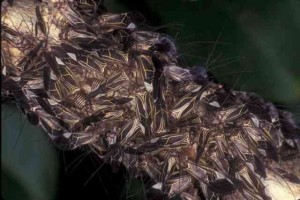
Tree cattle. Photograph by Jim Castner, University of Florida
by Larry Williams | Jun 17, 2013
There is something for the professional and homeowner at the 19th Annual Turfgrass Expo & Field Day. You’ll see and learn the newest in the areas of lawn grass varieties, weed control and many other topics related to selecting, establishing and maintaining a Florida lawn.
This University of Florida/Institute of Food and Agricultural Sciences (UF/IFAS) event will take place on June 19 at the West Florida Research and Education Center (WFREC) in the north part of Santa Rosa County.
Registration fee is $40. Register Online or register at the event. For more information, contact Robin Vickers at (850) 983-5216 ext. 113 or visit the WFREC website.
To read entire article, click the following link. 2013 Turfgrass Expo
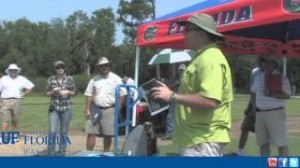
WFREC Turfgrass Field Day, Photograph UF/IFAS Extension









